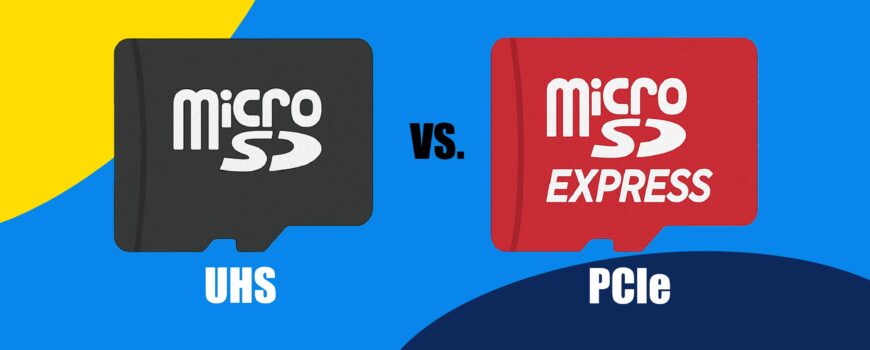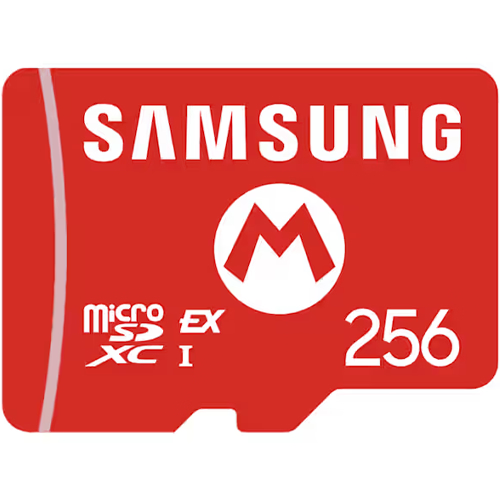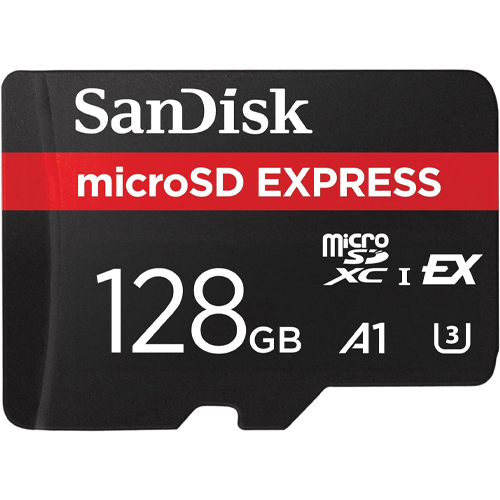MicroSD cards have long been one of the most widely used forms of portable storage. In fact they are the products we sell the most on BulkMemoryCards.com. They are compact, durable, and versatile, finding their way into smartphones, cameras, drones, handheld gaming systems, and even industrial devices. We sell to companies that put them in combo kits with different products that use them as primary storage devices. All the way to medical supply companies that use them for memory in tools they use in hospitals. Over the years, they have steadily improved in terms of capacity and speed, keeping pace with the demands of new technology. This article on MicroSD vs. MicroSD Express is for businesses, retailers, and consumers who need to choose the right storage solution today — and prepare for what’s coming to your industry.
But as file sizes grow larger and applications like 8K video, virtual reality, and high-speed gaming push the limits of what traditional MicroSD cards can handle, the SD Association has introduced a new standard: MicroSD Express. This next-generation format brings the kind of performance typically associated with SSDs into the tiny form factor of a MicroSD card.
At first glance, a MicroSD Express card looks just like a traditional MicroSD card. The difference lies inside: the technology powering MicroSD Express is built to deliver a massive leap in speed and efficiency.
MicroSD vs. MicroSD Express: Comparison Table
| Feature | Standard MicroSD (UHS-I / UHS-II) | MicroSD Express (PCIe/NVMe) |
|---|---|---|
| Maximum Speed | UHS-I: ~104 MB/s UHS-II: ~300 MB/s | Up to 985 MB/s (PCIe Gen 3 ×1) |
| Interface | UHS bus (1 or 2 rows of pins) | PCIe + NVMe (same as SSDs) |
| Power Efficiency | Optimized for consumer devices | Lower power per gigabyte transferred |
| Capacity Range | Up to 1TB widely available, 2TB supported | Same capacity range as standard MicroSD |
| Device Support | Nearly all smartphones pre 2020, cameras, drones, and computers | Very limited — only future (2025+) devices with Express support |
| Backward Compatibility | Fully supported across devices | Works in standard slots (at UHS speeds) but needs Express host for full speed |
| Best For | Photos, apps, 4K video, general storage | 8K video, VR/AR, professional workflows, future-proofing |
| Cost & Availability | Affordable, mass-produced, easy to find | Currently rare, higher cost expected |
A Quick Overview of Standard MicroSD Cards
The MicroSD card was first introduced in 2005 as a smaller alternative to the already-popular SD card. Since then, it has become the most common removable storage format worldwide.
Like SD Cards, modern MicroSD cards typically use the UHS (Ultra High Speed) bus interface. The two most widely available versions are:
- UHS-I: Offering speeds up to about 104 MB/s, UHS-I cards are still the most common and remain suitable for everyday tasks like app storage, HD video, and casual photography.
- UHS-II: Featuring a second row of pins, UHS-II cards can achieve transfer speeds up to about 300 MB/s. These are favored by professional photographers and videographers who need fast write speeds for high-resolution video or rapid burst shooting.
Capacities have also grown dramatically. What once seemed impossible is now commonplace — 512GB and 1TB MicroSD cards are widely available, with 2TB cards officially supported by the SDXC standard.
For most use cases, these cards are more than capable. They are affordable, widely compatible, and reliable enough for both consumer and business needs.
The Emergence of MicroSD Express
In 2019, the SD Association announced MicroSD Express, a new type of memory card designed to meet the future demands of storage technology. The key innovation is its use of the PCI Express (PCIe) interface and the NVMe (Non-Volatile Memory Express) protocol, the same technologies that power modern solid-state drives (SSDs).
While traditional MicroSD cards use the UHS bus, MicroSD Express cards take advantage of PCIe Gen 3 and NVMe, enabling transfer speeds of up to 985 MB/s — more than triple the performance of UHS-II cards.
This leap in speed is not just theoretical. In practical terms, MicroSD Express enables entirely new use cases:
- 8K and higher-resolution video recording and editing
- Augmented and virtual reality applications
- High-performance mobile gaming
- Edge computing and IoT devices requiring fast local storage
- Real-time data transfers in professional workflows
Essentially, MicroSD Express turns a storage card into something resembling a tiny SSD, capable of handling workloads that previously required much larger and less portable storage solutions.
MicroSD Express: Buying Advice for Businesses
When choosing between MicroSD and MicroSD Express, the most important factor is not just speed — it’s practicality. For businesses purchasing in volume, the key considerations are compatibility, cost per unit, and customer demand.
At this stage, standard MicroSD cards remain the smart investment. They are affordable, widely compatible with virtually all devices, and produced at scale, which keeps supply steady and pricing competitive. For resellers, retailers, or companies that preload data on cards, MicroSD is still the most reliable choice. Demand is strong across industries ranging from schools and marketing firms to photographers and manufacturers.
MicroSD Express is an exciting technology, but it is still in the early stages of adoption. Very few devices can take advantage of its full performance potential, which makes it an unnecessary expense for most end users. While some forward-looking businesses may choose to keep a small stock of MicroSD Express for niche customers, it is not yet a practical option for large-scale purchasing.
In short:
- Today’s best choice for bulk orders is standard MicroSD, especially UHS-I and UHS-II, which balance cost and performance.
- MicroSD Express is worth monitoring as the industry shifts toward higher performance requirements, but it does not yet have the widespread device support needed for everyday resale.
For businesses that need low-cost, high-quality cards in volume, traditional MicroSD remains the safest and most profitable investment.
Technical Breakdown: How They Differ
On the surface, both formats share the same familiar MicroSD form factor. But the underlying technology is very different. Here are some ways to look at the differences between MicroSD vs. MicroSD Express.
Interface and Protocol
- MicroSD: Relies on the UHS bus (UHS-I, UHS-II, or UHS-III).
- MicroSD Express: Uses PCIe (up to two lanes) with NVMe, similar to the drives inside modern laptops.
Speed
- MicroSD UHS-I: Up to 104 MB/s.
- MicroSD UHS-II: Up to ~300 MB/s.
- MicroSD Express: Up to 985 MB/s (with potential for higher speeds in future PCIe generations).
Compatibility
- MicroSD: Universally compatible. Nearly all smartphones, cameras, and handheld devices accept UHS-I cards, and many professional cameras support UHS-II.
- MicroSD Express: Backward-compatible in theory (can work as a standard MicroSD card in non-Express slots), but to unlock Express speeds, the host device must specifically support PCIe/NVMe over MicroSD. Currently, few devices offer this support.
Power Efficiency
NVMe and PCIe are designed for modern, efficient data transfers. Despite their speed, MicroSD Express cards can potentially use less power per transferred gigabyte than traditional UHS cards, making them more efficient for demanding applications.
Current Adoption and Availability
While the SD Association announced MicroSD Express in 2019, adoption has been slow. At present, there are very few consumer devices that support MicroSD Express. Camera manufacturers, smartphone makers, and gaming console developers have not yet widely adopted the new standard.
This is partly because existing UHS-II cards already meet the needs of most consumers, and partly because device manufacturers are cautious about adding support for a new standard before there is proven demand.
Meanwhile, standard MicroSD cards continue to dominate the market. They are produced in high volumes, available at very low cost per unit, and work in virtually every device. For businesses and resellers, these factors keep MicroSD the go-to choice.
Looking Ahead: The Future of MicroSD Express
Technology trends are clear: file sizes are increasing, resolution demands are climbing, and new applications require faster storage than ever before. As devices evolve, MicroSD Express will likely become more relevant. So it’s less about MicroSD vs. MicroSD Express, and more about how each one currently fits into the market, and where you think you will start to see Express cards in the future. Is you industry taking advantage of extra Express speeds?
Possible areas of growth include:
- Next-generation cameras and camcorders supporting 8K+ video.
- Gaming consoles and handheld devices requiring near-SSD performance in a compact format.
- Industrial and IoT applications that need efficient local storage with high-speed data logging.
Conclusion
The difference between MicroSD and MicroSD Express boils down to technology and speed. Traditional MicroSD cards remain the best option for everyday use: affordable, widely compatible, and available in massive capacities. MicroSD Express, on the other hand, represents the future of portable storage — offering SSD-like performance in a tiny package, but waiting on device manufacturers and market demand to catch up.
For businesses, the smart move is to continue investing in standard MicroSD while keeping an eye on Express developments. When adoption accelerates, those prepared to adapt will be positioned to offer cutting-edge solutions to customers.



